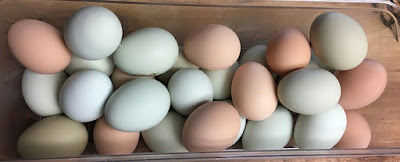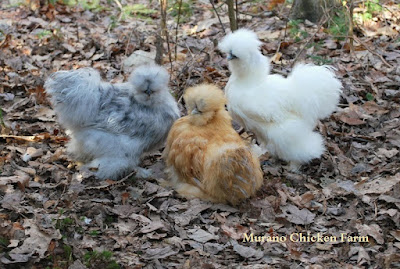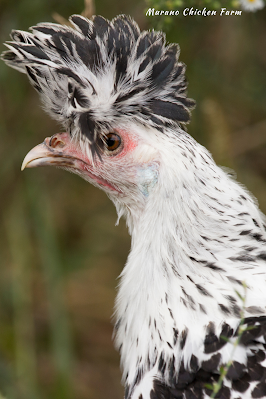A few years back I was helping Brinsea incubators with their displays and demonstrations at the Mother Earth News fair when it was in Pennsylvania. I had the eggs all ready to hatch but the one problem was that most of them were brown! When demonstrating candling eggs and incubation equipment you can see inside the egg most easily if it's white or cream colored. The darker the shell the harder it is to see inside.
I had brown and white partially incubated eggs with me, but the white ones were from the silkies, so they were rather small white eggs since silkies are bantam sized. This sent me on a quest to find a standard sized white egg laying breed. I found several!
Lots of people that raise chickens for eggs like to pick and choose their chicken breeds so that they have different colored eggs. It's often referred to as 'a pretty egg basket' or 'a rainbow egg basket'.
Chicken eggs come in many colors the most common are blue, green, brown and white. Admittedly, most people are only familiar with white and brown eggs and many people don't even realize you can own chickens that lay white eggs!
I was once told that only egg farms are allowed to have them. lol I should probably add that to the post I wrote about things non chicken keepers believe...but for now lets move on to the white egg layers!
There are several breeds that lay white eggs and they are all readily available from hatcheries and private breeders alike. Just like brown eggs come in various shades though, white eggs come in both pure white and off white or cream colored.What make an eggshell white?
All eggs start out as calcium carbonate which is white, so way back at the beginning every single egg is white. Obviously white eggs remain white but the ones that are going to be brown eggs travel down the oviduct as white and the color is applied right before the egg is laid. With blue eggs however, the color (called oocyanin) is applied as the shell is formed and so it can sink through to the inside of the shell.This is why the inside shell of a blue egg is blue but the inside shell of a brown egg is white. It all has to do with the timing of when the color is applied. As you can see there are really only two colors of eggs white and blue, the other colors are just a coating of 'paint'.
Do white eggs taste different?
Nope, not in the least little bit, but some people think they do! The thing is, they taste exactly the same as any other farm fresh egg from the same place.
I have a theory on why people say different colored eggs taste better. I discussed this in my article on Marans eggs, but here's a quick overview: since most white eggs people have are factory farmed and most brown eggs are small farm/backyard flock, white eggs are perceived as having a weaker flavor than brown, blue or even green eggs because they aren't fed as healthy of a diet and cannot access nutritious bugs and plants to graze on.
Mass produced eggs definitely taste different than small farm eggs however, if you put a few brown egg layers in with that factory farm flock the brown eggs they lay would taste the same as the white eggs! It all has to do with diet.
It's confusing to write out! Lol Moral of the story though, is egg flavor and even yolk color depends on the chickens diet not the shell color. That being said, having white, blue, green & brown eggs in your egg basket is fun, plus the whites are easier to candle if you want to hatch chicks!Here are the breeds you'll want to raise if you want to collect white eggs from your coop...
Which chickens lay white eggs?
Lets talk about the different breeds of chickens that lay white eggs. Some of these are very easy to find and others are quite rare, but you should be able to find many of them! (these are in no particular order)Leghorn chicken
The Leghorn chicken is probably the most common breed on this list. Most major hatcheries should carry them though private breeders are rater rare. The leghorn originated in central Italy and though 10 color varieties are recognized, the most common feather color is white.Most leghorns have single combs and white earlobes. They lay about 280 medium to large eggs a year, but that can fluctuate up to 320 eggs a year!
Polish chickens
The Polish chicken is a European breed of chickens known for their head crests. It's believed that they came to America between 1830 & 1840. There is both standard and bantam size Polish chickens. They come in both bearded variety and no beard.Polish chickens have white earlobes, a small V shaped comb on the rooster and the hens have very small to no wattles. Hens lay a medium to large sized white egg. The hens lay about 150 eggs per year and are rarely broody.
Related reading: The polish chicken: Should you raise them?
Ancona chicken
The Ancona originated in central Italy and are known for their black feathers which are mottled with white. Some of these feathers have a v-shaped white marking at the tip. They have white or cream colored earlobes and a medium size straight comb. There's also a rose comb variety. They lay about 220 medium sized white eggs per year.
Calfornia white chicken
The California White is a hybrid egg laying strain developed in the US. They're only available from a few breeders but if you find them, they lay over 300 white eggs yearly... So they're probably worth adding to your flock! They occasionally have some black flecks or streaks on their white feathers.Hamburg chicken
The Hamburg is a small to medium-sized breed that is believed to have originated in Holland. They do not come in bantam size. They lay about 200 medium sized white eggs a year. They're known to be a little flighty, have a rose comb and come in 11 different color varieties!Minorca chicken
Of all the chickens on the list the Minorca probably lays the largest sized white eggs! The black Minorca is available from a hatchery or 2 in the US but the options appear to be dwindling as there are less available now than a few years ago when I last looked.They are believed to have been developed by the British from birds from the island of Menorca. This breed comes in white, black or buff. They have red wattles and white earlobes and lay about 280 large eggs a year.
Sicilian Buttercup chicken
The Sicilian buttercup chicken comes in both bantam and standard sizes. They were originally bred in Sicily and have a buttercup shaped comb, hence the name. They are golden buff color with black markings on the body and tail feathers. They're a heritage breed chicken that can be harder to find today, but they do lay about 180 eggs per year.Campine chicken
The Campine originated in Belgium. They come in silver and gold color, which are cute color names but really they're white or tan. They have black detailing on some of the white or tan feathers. They're kind of flighty and a bit rare. They have a single comb which tends to flop over to the side. The Campine is known as a hearty egg layer, laying an egg almost every day.Lakenvelder chicken
The Lakenvelder originated in Germany. It has black and white feathers with the white feathers being on the body and the black being towards the head and tail. They have a single comb with large red wattles and white earlobes. The hens lay up to 160 medium sized white eggs a year.
Silkie chickens
The well-known Silkie chicken is a fluffy bantam breed known for their mild temperament and broodiness that originated in China. Silkies cannot fly because of their unique feathers which are not smooth because they lack barbicels.Silkies have crests and feathered feet and come in bearded and non-bearded varieties. Silkies have bluish colored earlobes and a walnut shaped mulberry comb with very small to no wattles. They have five toes on each feet and black skin.
Silkie hens lay a small cream colored egg, and while they lay quite well, they only end up laying about 100 eggs a year because they go broody so often!
Related reading: You should raise silkie chickens!
White faced Black Spanish chicken
The white face black Spanish chicken is a breed of domestic chicken which originated in Spain. They are known for their white faces and glossy black feathers. The roosters have a straight comb. They lay about 160 to 180 eggs a year.Sumatra chickens
The Sumatra chicken is from the island of Sumatra in Indonesia. They are known for the roosters long flowing tail feathers and tend to stand more upright than other chicken breeds, which makes them seem sort of pheasant like.They have a pea comb and are considered an ornamental breed as they are fairly small. The roosters can have multiple spurs on each leg. The hens lay about 100 smallish white eggs per year.
Apenzeller Spitzhauben chicken
I saved this one for last because it's the most fun to say! While it's not an American Poultry Association recognized breed, they are pretty well known to the public for their pretty spangled feathers and crazy hairdos!
This breed originates from Switzerland and is well known for their V comb and crazy feather crests! The crest stands straight up but sort of falls forward, not sideways or back like polish chickens! It looks kind of like a mohawk! The hens only lay about 150 medium to large sized white eggs per year.
Related reading: Best chicken breeds for beginners.
Which breed of white egg laying hen should I buy?
If you want a white egg laying hen Leghorns, Silkies and Polish are probably the most easily available. Many of them are available from commercial hatcheries though I always recommend breeds like silkies or sumatras that have a specific characteristic be purchased from an actual breeder because they care more about staying true to the APA standards.
Make sure to do some research into the cold or heat hardiness of whatever breed you're considering just to make sure it will thrive in your climate!
How do you pick the hens you raise? By egg color, feather color or some other desired quality? If you want the lowdown on all the different colors of eggs different chicken breeds lay (including black!) check out: Which breeds to raise for pretty eggs.Want to know more about raising chickens? Click here for my most read chicken keeping articles!
~L
Want information on raising chickens sent right to your email weekly? Click right here to join my list and get new posts sent directly to you the day they're published ... plus, you'll also get the free download '25 Ways to save money raising chickens'.






No comments:
Post a Comment